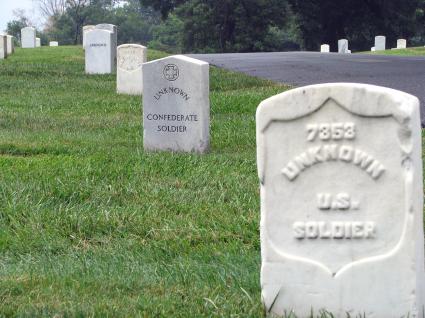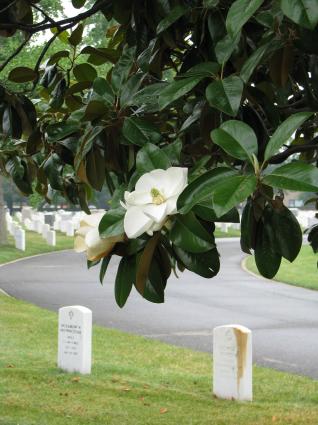People’s willingness to share is one of the wonderful aspects of genealogy. A reader contacted me recently to provide further information about a common tangential ancestor — one not directly related to either of us but who had married into the larger family of Howder descendants — and for whom I’d had only the sketchiest of records. I knew that the common ancestor served in the Civil War. However, I didn’t know his story. What circumstances led to his death and then to his burial in Arlington National Cemetery?
I wanted to record the exact longitude and latitude of the burial site. So I used methods and tools explained in my earlier GPS and Genealogy post. Yesterday I was able to drive over. Naturally I parked in that little section of North Arlington that is south of Route 50. Then, using my trusty handheld Global Positioning System (GPS) device to track my path, I forged through the Ord-Weitzel Gate and into the cemetery.
Actually I wanted to record two spots. Hold on, I’ll get to that in a moment.
Into the Cemetery
I used coordinates captured by my GPS to create the simple map, above. Go ahead and click on the markers. Notice what I found along with the exact long/lat coordinates. These waypoints should be accurate to within 20 feet of the actual locations. Then the historian in me also got into the act. I recorded the experience with other digital media including video and photographs.
Ananias STAFFORD
I wanted to find Ananias Stafford. Records indicated that I could find him in Section 27, plot 463. This is the oldest part of the cemetery and Mr. Stafford’s body arrived there just weeks after its opening. Surely nobody at the time could anticipate that nearly 300,000 more would follow. Nor did anyone realize that Arlington would become amongst the most hallowed ground in the nation.
Genealogy is much more than simply the collection of names. Rather, I prefer to use the term “personal history.” And there is a tragic story behind Ananias Stafford’s journey to Arlington. He entered the war later than many soldiers when he volunteered to serve in the Michigan Cavalry in 1864. That may have been due to his age. He was already in his 30’s and the army valued younger men during those early years of the conflict. Then the Army deployed him immediately to the Overland Campaign. He saw action at the Battle of the Wilderness and other nearby conflicts.
A bullet pierced his chest within three months of his enlistment. He fell while fighting at the Battle of Haw(e)’s Shop on May 28, 1864. Ananias suffered for another month at Emory Hospital in Washington, DC before finally succumbing in late-June (the date on the tombstone is incorrect). He left behind a wife and two small children in Perry Township, Shiawassee County, Michigan. He had farmed there before his brief service in the cavalry.
Lewis & Jane Howder
I climbed up the hill. Then I paid my respects to my Howder great-grandparents in Section 17, plot 21321, as I’ve done a number of times over the years.
Geologically the cemetery rests on that very spot where the coastal plain begins to buckle with the first bumps of the Piedmont. At this spot it creates a formation called the Arlington Ridge. Climbing to the top of the ridge on a typically humid Washington summer morning got the heart pumping and sweat beading on my brow.
Lewis Howder and Jane (Hayes) Howder rest at the very back of the cemetery, near Fort Myer. That’s a world away from the tourmobiles and the crowds. Few people venture this far back into the cemetery unless they have family to visit. Lewis and Jane had a much less dramatic story than Ananias Stafford. They lived, worked and raised a family in Washington, DC in the early 20th Century. They now spend eternal peace in a shared plot in a quiet, restful place.
Additional Reflection

Arlington National Cemetery creates an atmosphere that allows visitors to appreciate the supreme sacrifices made by our armed forces. As I walked back from my great-grandparents plot, I noticed and was touched by the poignancy of these markers for an unknown Union and Confederate soldier laying next to each other. Like in my family, many of us can trace back to ancestors that fought on both sides of the conflict.
The crowds congregate respectfully at the Tomb of the Unknowns. Yet many don’t realize that row-upon-row and indeed entire fields of unknown soldiers rest just up over the hillside in the lesser-visited sections of the cemetery. Each one of these represents a father or a son who marched to battle while a family waited vainly for his return, always wondering and never learning his fate.

This is a final shot from my July 5 visit to Arlington National Cemetery. I didn’t intend to capture anything historical. I simply stopped for a moment to appreciate how the landscaping highlighted the sacredness of these grounds.

Leave a Reply